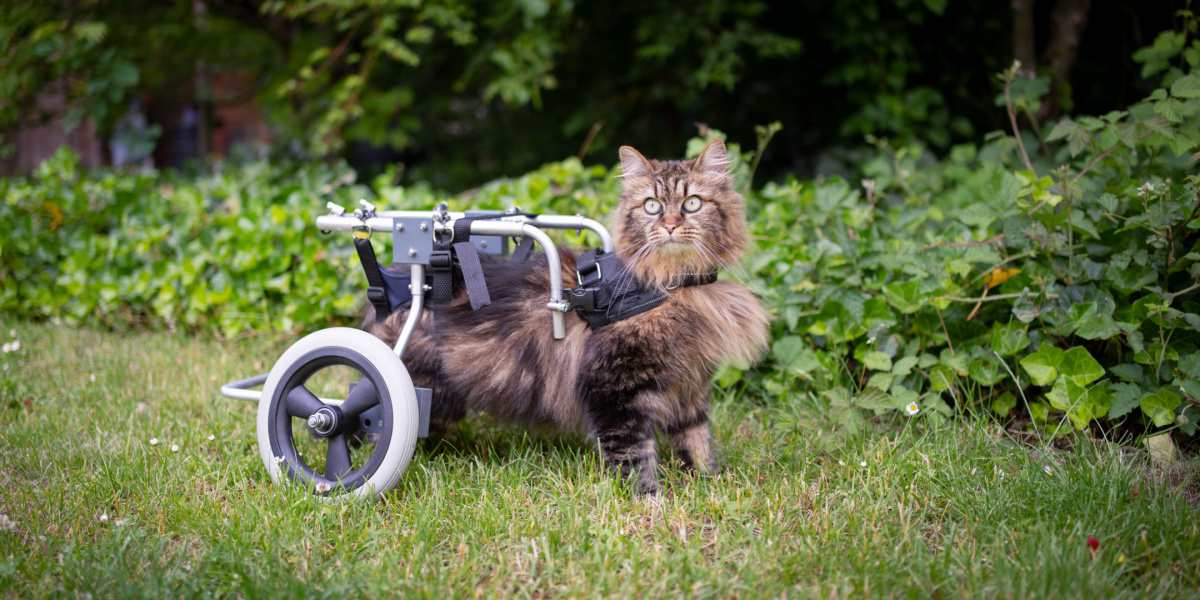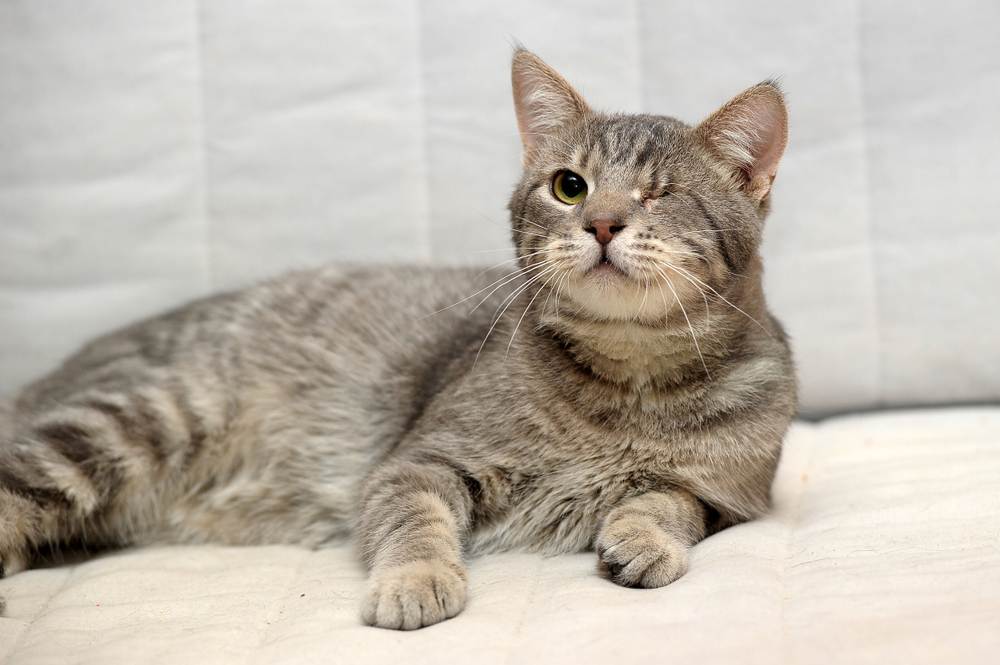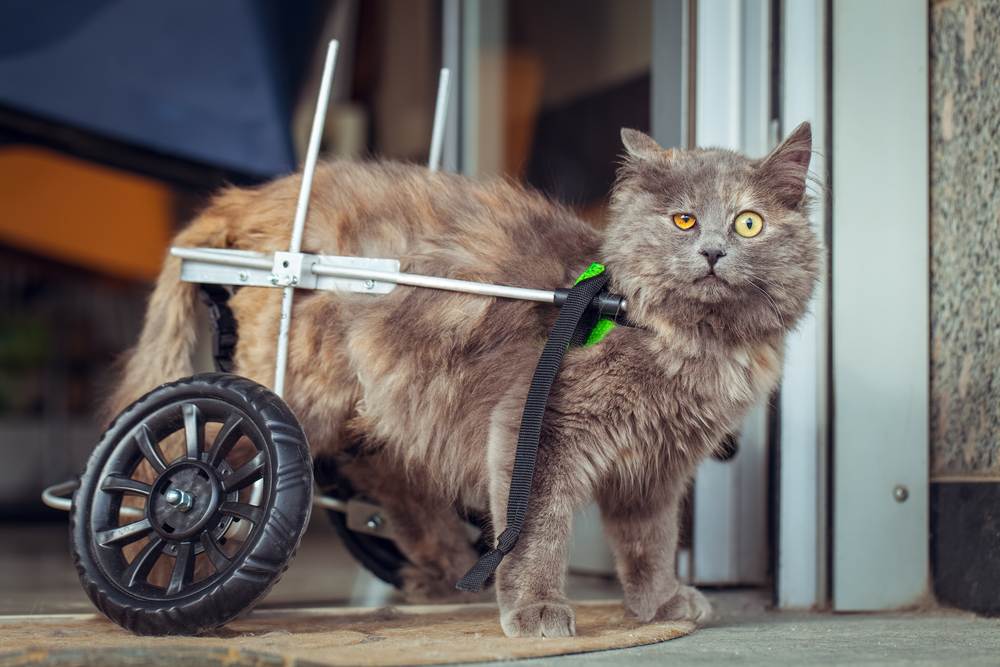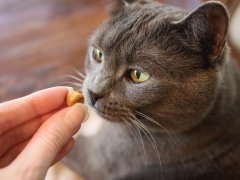
Have you ever considered adopting a disabled cat? By definition, disabled cats are those with physical or mental conditions that limit their movements, senses, or activities. Cats can be born with disabilities such as blindness, deafness, or limb deformities. Disabilities can also develop with age, or be the result of an illness, accident, or injury.
Unfortunately, while everyone fawns over cute kittens and young cats requiring homes, many disabled cats are overlooked in animal shelters. Cats with disabilities may have physical limitations, but many animals with special needs lead very happy, fulfilled lives in the right loving and caring homes. In general, there are ten very important things you need to know before you decide on adopting a disabled cat.
Many people want to adopt cute kittens and younger cats, but disabled kitties are often overlooked in shelters. Adopting a disabled cat can be a hugely rewarding experience. A special needs pet can also be a big commitment of your time, emotions, and finances.Key Takeaways
1. Go Back to Basics – Is a Cat the Right Pet for Me?
Given that you are reading this article, it is likely that you have already thought long and hard about adding a wonderful feline companion to your home. Before considering if you could open your heart to a disabled cat needing extra care, make sure you have read our general article on adopting a new cat.
Ensure you have considered if you would like a kitten or adult cat, researched routine health care like vaccinations and flea and worm treatments, and that nobody in your household is allergic to cats.
2. Research the Specific Disability
As the saying goes, “forewarned is forearmed.” This is very true when taking on a special needs animal. Get advice from trusted sources such as veterinarians, trainers, animal welfare organizations, and behaviorists to ensure that you are fully prepared for the extent of your prospective pet’s disability, and how it is likely to affect them throughout their lifetime.
For example, a cat that has recently had a limb amputated is likely to require more help and adaptations to their living arrangements initially, but over time will likely adapt very well, and need minimal ongoing care. Conversely, a cat with permanent nerve damage affecting their mobility and ability to pass urine and feces will always require a high level of day-to-day nursing care.
See if you can visit someone with a cat with the same disability to discuss and learn about their care, and consider if your own home may be a good fit for a similar cat.
3. Do You Have Other Pets or Children?
Cats with certain disabilities require quiet, calm homes without the hustle and bustle of busy family life and other pets.
Blind cats tend to be startled if they are approached without talking gently to them first to alert them of your presence. Clutter on the floor should be avoided as they may hurt themselves by bumping into unexpected objects – anyone with kids knows that mess and clutter can be a challenge to avoid! In general, blind cats cope very well by using their other senses to help them navigate their surroundings, but everything should be kept as constant as possible.
Deaf cats may be very quiet, or extremely noisy, depending on the individual’s personality and coping mechanisms. This may startle other pets or children. Deaf cats should be approached with heavy, slow steps so they are not startled. They may be frightened by being stroked or picked up without warning.
Despite these potential issues, beautiful relationships can form between disabled animals and other pets and children, as long as plenty of thought, time, and patience is put into matching the individuals involved.
4. Is Your Home Adaptable?

Many disabled cats can adapt to their surroundings with time and with the aid of their owners.
Some disabled cats need special modifications to make your home suitable and safe for them. Stairs can be dangerous for blind cats, and those with physical limitations such as cerebellar hypoplasia (wobbly cat syndrome), stair-gates can be used to prevent any mishaps.
Blind cats are especially vulnerable to injury. Ideally, they should be prevented from jumping onto high surfaces or tall items of furniture. This may involve preventing them from accessing certain rooms of the house.
Small steps can be used to make life easier for cats with mobility issues due to limb amputation or arthritis so that they can safely get to favorite spots like beds and sofas.
Cats with mobility issues following limb loss may find litter boxes with low sides easier to access. Conversely, wobbly cats tend to find high-sided litter boxes help them balance to pass urine and feces.
Carefully positioned, easily accessible, sturdy food and water dishes are needed for cats that may knock them over due to blindness or mobility issues.
It is vital to microchip your special needs cat. If they accidentally escape from your house, they are less likely to find their way home unassisted.
5. How Can I Enrich Their Life?
Deciding whether to let your cat have free access to the outside can be a tough decision for cat owners. While it may enrich their lives in some respects, there are dangers from traffic, injuries, and other animals.
For many animals with disabilities such as blindness and deafness, the answer is more straightforward: it is far too dangerous for them to go outdoors alone. Their lives can be hugely enriched, however, by having access to a fenced run, catio, or cat-proofed garden where possible.
Toys and puzzle feeders help to enrich the environment of any cat, but especially those with limitations requiring them to stay indoors. Horizontal scratching posts are available, which will be easier for some cats to use than the traditional vertical ones.
6. What Are the Financial Implications?
Before adopting any pet, it is very important to consider the cost of looking after them throughout their lifetime. This includes the cost of preventative healthcare, neutering (spaying or castrating), food, cat litter, and boarding costs. Veterinary care and medications can be another large expense for pet owners. This can be budgeted for by taking out medical insurance for your cat.
Unfortunately, most pet insurance companies will not cover a pre-existing health condition that began before the policy was taken out. Although some rescue organizations help with ongoing costs, it is vitally important to have a realistic idea of the likely veterinary costs for your prospective cat’s care. It is still well worth considering insuring your pet to cover for other illnesses or injuries that may occur in the future such as diabetes or kidney disease.
7. Frequent Visits to the Veterinarian
Along with the financial costs, consider if you have easily available transportation and enough free time in your schedule for frequent visits to the veterinarian if your cat’s disability requires them.
8. Do You Have Time in Your Schedule?
Although some disabled cats cope very well and have no additional care requirements, others have complex needs that can be time-consuming for their owners. As well as spending time playing and bonding with your cat, you will also have to devote extra time to grooming and bathing them if they are unable to do it for themselves. They may require daily medications or physiotherapy at specific times, which will need to be factored into your daily routine and schedule.
9. Are You Prepared for an Emotional Rollercoaster?

Adopting a disabled cat can be both rewarding and emotionally difficult.
Sharing your life with a disabled cat can be a hugely rewarding experience; what they may lack in physical capabilities, they usually make up for in their loving personalities. However, it requires lots of patience, understanding, and perseverance to care for a cat with complex medical or physical needs. It can be very upsetting to cope with behavioral issues or to see your pet struggling to adapt to a recent amputation or blindness. Prepare yourself as much as possible with what to expect.
10. Find Your Support, and Celebrate Your Cat’s Uniqueness!
There is lots of help, advice, and support available for owners of pets with disabilities – May 3rd is now celebrated as National Specially-abled Pet Day, recognizing the bravery, tenacity, and uniqueness of pets that are thriving against the odds. Getting involved with like-minded people can help make the journey ahead feel less daunting.
Making the Final Decision
Although there are many important considerations for potential adopters of disabled cats, offering a home to cats that are often overlooked in shelters can be a wonderful, life-altering experience for all involved.
Before making your final decision on adopting a special needs cat, is vitally important to ensure that your home is a good fit for one. Carefully consider your lifestyle and what modifications a cat will need for their safety and well-being, as well as their ability to thrive.







